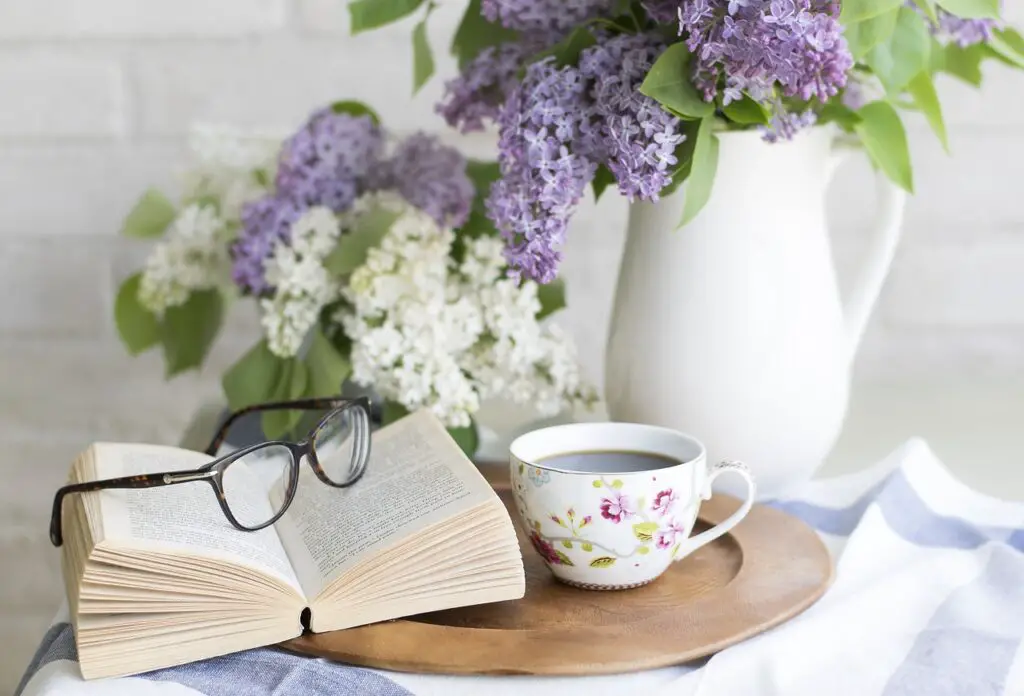Transform your home into a clutter-free sanctuary by embracing core minimalist principles. Start by sorting your belongings into keep, donate, sell, and discard piles, focusing on items that truly add value to your life. Implement the one-in-one-out rule to prevent accumulation, and create functional zones throughout your space for specific activities. Use smart storage solutions like adjustable shelving and clear containers, while maintaining daily habits such as quick resets and regular decluttering sessions. Establish a digital organization system to minimize paper clutter. The path to a serene, organized home starts with these foundational steps.
Core Principles of Minimalist Living
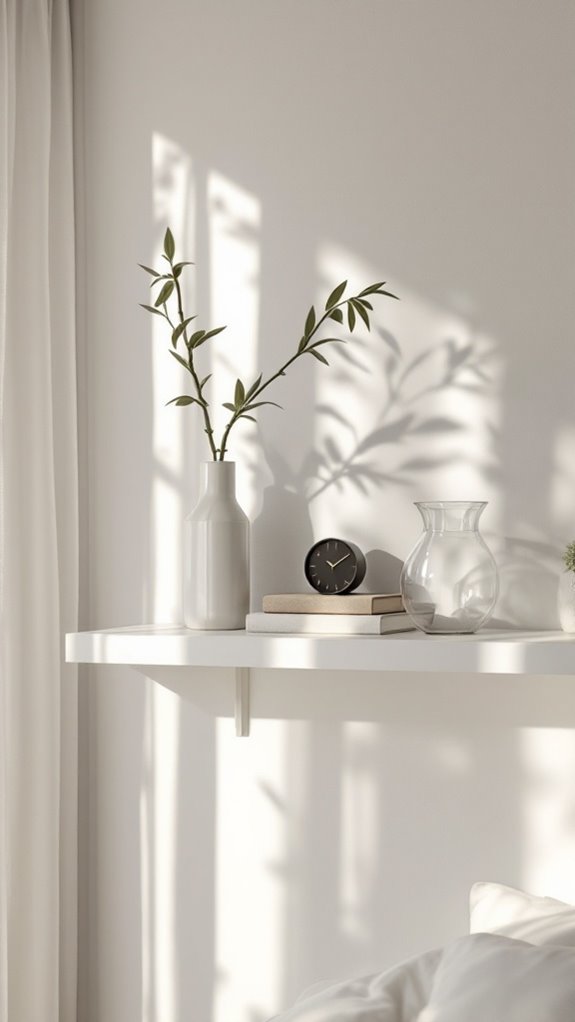
At the heart of minimalist living lies a commitment to intentional, clutter-free spaces and purposeful choices. To embrace minimalism, you'll need to adopt core principles that guide your decisions about what enters and remains in your home. These principles serve as a foundation for creating a simplified, organized living environment that promotes peace and functionality.
The first principle is quality over quantity. Instead of accumulating numerous items, you'll focus on keeping only high-quality pieces that serve multiple purposes or bring genuine value to your life. This means carefully evaluating each purchase and regularly examining your belongings to confirm they earn their place in your home.
Another essential principle is the one-in-one-out rule. When you bring a new item into your space, remove something similar to maintain balance. This practice prevents accumulation and helps you maintain your decluttered environment long-term.
Mindful consumption forms the third principle. You'll learn to question each potential purchase by asking yourself: "Do I need this? Will it add value to my life? Do I have space for it?" This thoughtful approach naturally reduces impulse buying and unnecessary acquisitions.
The final core principle is regular maintenance. You'll need to establish routines for decluttering, organizing, and reevaluating your possessions.
Schedule monthly reviews of your spaces, and don't let papers, clothes, or other items pile up. By staying consistent with these maintenance practices, you'll prevent the gradual creep of clutter that can undermine your minimalist goals.
Decluttering Your Space
Before diving into minimalist living, you'll need to master the art of decluttering your space. Start by dividing your belongings into four categories: keep, donate, sell, and discard. This systematic approach helps you make decisive choices about each item you own.
Begin with visible clutter first – items on countertops, tables, and floors. Pick up each object and ask yourself if it serves a purpose or brings genuine joy. If you haven't used something in the past six months, it's likely time to let it go. Don't keep items out of guilt or future "what-if" scenarios.
Move through your home room by room, tackling one space at a time to avoid feeling overwhelmed. Sort through drawers, cabinets, and closets methodically. Pay special attention to common clutter magnets like junk drawers, garage storage, and paper documents.
Digitize important papers and shred the rest. Focus on keeping only what you need and use regularly. For clothes, try the hanger trick: turn all hangers backward, and only turn them forward when you wear an item.
After six months, donate anything still facing backward. Apply similar rules to books, kitchen gadgets, and decorative items. Create designated spaces for everything you keep, and maintain organization with the "one in, one out" rule – when you bring in something new, remove something old.
Remember that decluttering isn't a one-time event but an ongoing process of mindful consumption and regular maintenance.
Storage Solutions That Work
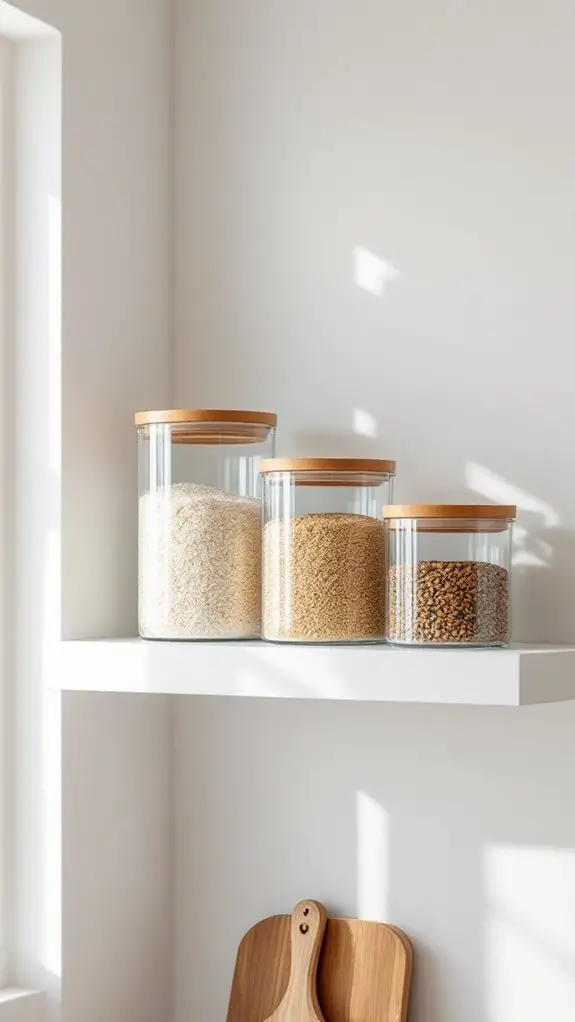
Effective storage solutions come into play once you've cleared away the clutter. The key is to maximize your existing space while maintaining easy access to items you regularly use.
Start by measuring your available storage areas and investing in adjustable shelving systems that can adapt to your changing needs.
Consider utilizing vertical space with wall-mounted shelves and hooks, which free up valuable floor area while keeping items visible and accessible.
Install drawer organizers and dividers to prevent small items from becoming jumbled, and use clear containers to store similar items together. You'll find it easier to maintain organization when everything has a designated spot.
Make the most of awkward spaces by adding pull-out storage solutions to deep cabinets or installing corner shelving units. Don't overlook the backs of doors, which can accommodate hanging organizers for shoes, accessories, or cleaning supplies.
Under-bed storage containers on wheels provide easy access to seasonal items or extra linens.
Label everything clearly and consistently. You'll save time searching for items and be more likely to return them to their proper places.
Choose stackable containers with straight sides to maximize space efficiency, and opt for sizes that fit your storage areas without wasting space.
Remember to keep frequently used items at eye level and store rarely used ones in higher or lower spots.
Create zones based on activity – cooking items in the kitchen, office supplies in the workspace, and cleaning materials near where you'll use them.
This systematic approach guarantees your storage solutions remain practical and sustainable.
One In, One Out Rule
The simple "one in, one out" rule serves as a powerful foundation for maintaining a clutter-free home. This principle requires you to remove one existing item whenever you bring a new one into your space. By following this straightforward approach, you'll prevent accumulation and maintain the organized environment you've worked hard to create.
To implement this rule effectively, you'll need to make it a habit. Before purchasing anything new, consider which item you'll remove to make space for it. This practice helps you become more mindful of your consumption patterns and encourages thoughtful decision-making about what truly deserves a place in your home.
Start by applying this rule to specific categories like clothing, books, or kitchen items. When you buy a new shirt, remove one from your closet. If you acquire a new cookbook, donate or sell an old one. This method works particularly well for maintaining organization in limited spaces and preventing overcrowding in storage areas.
The rule also helps you assess the true value of your possessions. You'll find yourself asking important questions: "Do I really need this new item?" "Is it worth replacing something I already own?" "Which existing item no longer serves me?" These reflections lead to more intentional purchasing decisions and a deeper appreciation for what you already have.
Remember that exceptions can exist for consumables like food or cleaning supplies. Focus on applying the rule to permanent items that tend to accumulate and create clutter in your living space.
Digital Organization at Home
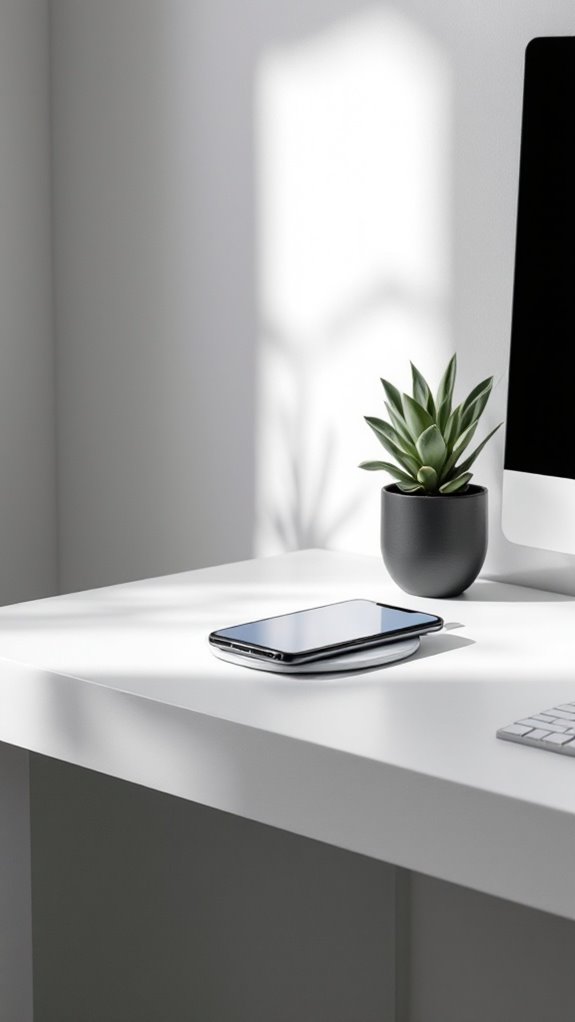
Just as physical clutter can overwhelm your living space, digital clutter can create chaos in your home's electronic environment. From overflowing email inboxes to disorganized photo libraries and scattered documents, digital mess can slow down your devices and make finding important files frustrating. Taking control of your digital life is essential for maintaining a truly minimalist home.
Start by creating a logical folder structure on your devices. Organize files into main categories like Documents, Photos, Videos, and Projects, then create relevant subcategories. Name your files consistently and clearly, including dates when applicable.
Delete duplicate files, unused applications, and old downloads that you no longer need. Back up your essential files to both cloud storage and an external hard drive, then delete unnecessary local copies to free up space.
Use cloud services strategically – choose one primary service for personal files and another for work-related materials to avoid confusion. Tackle your email by unsubscribing from newsletters you don't read and creating filters to automatically sort incoming messages.
Set up folders for different purposes and maintain a clean inbox by following the "touch it once" principle – deal with emails immediately rather than marking them for later. For photos and videos, regularly delete blurry or duplicate shots, and organize the keepers by date and event.
Use photo management software to tag people and places, making searches easier. Consider digitizing physical photos and important documents to reduce physical clutter while maintaining organized digital copies.
Creating Functional Zones
Creating distinct zones within your living space forms the foundation of a well-organized minimalist home. By designating specific areas for different activities, you'll reduce clutter, increase efficiency, and maintain a sense of order throughout your home. Start by identifying your daily activities and the spaces where they occur most naturally.
Begin with your entryway by establishing a landing zone for keys, shoes, and outerwear. Install hooks at eye level, add a slim console table, and incorporate a designated spot for incoming mail.
In your kitchen, create zones for food prep, cooking, cleaning, and storage. Position your tools and ingredients close to where you'll use them, keeping countertops clear except for frequently used items.
Your living room should feature distinct areas for relaxation, entertainment, and potential work or study space. Use furniture placement and rugs to define these zones visually.
In bedrooms, separate sleeping, dressing, and storage areas. Keep your nightstand minimal with only essential items, and guarantee your closet has clear zones for different clothing categories.
If you work from home, establish a dedicated workspace that's separate from living areas. Include only the necessary equipment and supplies, creating zones for active work, reference materials, and equipment storage.
In bathrooms, divide the space into grooming, shower, and storage zones, keeping products where you use them.
Remember to maintain clear pathways between zones and avoid overcrowding any area with unnecessary items.
Minimalist Kitchen Setup
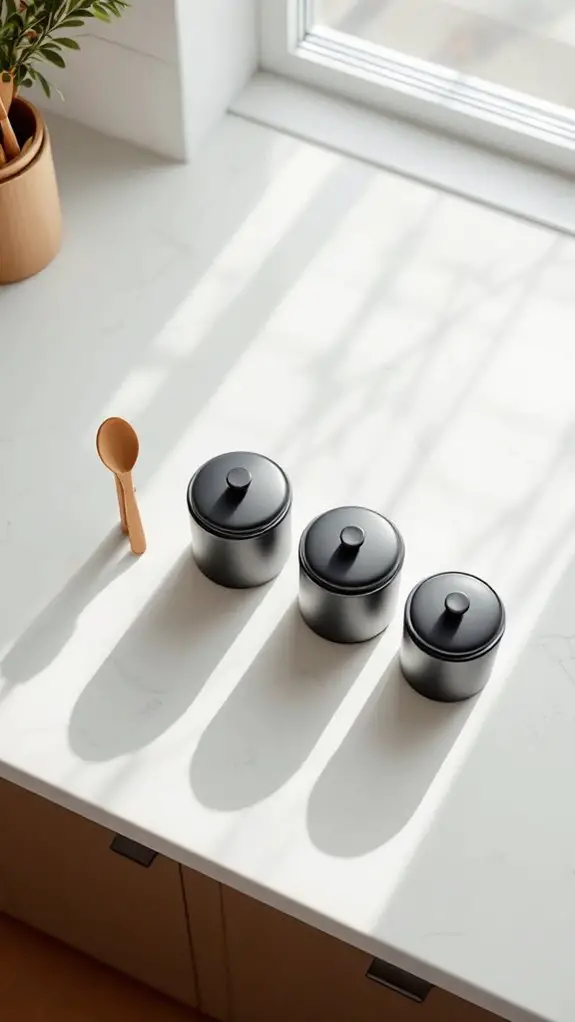
Building on the concept of functional zones, a minimalist kitchen setup starts with clearing every surface and keeping only what you need for daily cooking. Remove rarely used appliances, duplicate utensils, and decorative items that collect dust. Your countertops should feature only essential items you use daily, such as a coffee maker or knife block.
Organize your cabinets into distinct work zones: cooking, food prep, cleaning, and storage. Place pots, pans, and cooking utensils near the stove, cutting boards and prep tools near your main workspace, and cleaning supplies under the sink. Store food items in clear containers and group them by category in your pantry.
Implement the "one in, one out" rule to maintain your minimalist kitchen. When you acquire a new item, remove an old one. Keep only the dishes you need for your household plus two extra place settings for guests. Edit your grocery shopping to prevent food waste and overstocked shelves.
Maximize vertical space with hooks, magnetic strips, and wall-mounted organizers. Install pull-out drawers in deep cabinets to access items easily. Use drawer dividers to keep utensils organized and prevent cluttered jumbles.
Label everything in your pantry and refrigerator to track expiration dates and maintain order. Consider using a uniform set of storage containers to create visual harmony and stack items efficiently.
Keep your sink empty and wipe counters regularly to maintain the clean, minimalist aesthetic you've created.
Capsule Wardrobe Basics
A well-planned capsule wardrobe consists of 30-40 versatile pieces that mix and match effortlessly. You'll need to select high-quality basics in neutral colors like black, white, navy, and beige, ensuring each item coordinates with at least three others in your collection.
Start with essential pieces: two pairs of jeans, three pairs of trousers, five basic t-shirts, three long-sleeve shirts, two sweaters, and two blazers.
Focus on selecting clothes that suit your lifestyle and climate. If you work in a professional environment, include more tailored pieces. For casual settings, opt for comfortable yet polished items. Choose fabrics that maintain their shape and color after multiple washes, such as cotton, wool, and quality synthetic blends.
Your capsule wardrobe should include seasonally appropriate outerwear and accessories. Select one winter coat, one lightweight jacket, two pairs of everyday shoes, and one pair of formal shoes. Add five accessories that complement multiple outfits, such as scarves, belts, or jewelry pieces.
Maintain your capsule wardrobe by evaluating items every three months. Remove pieces that don't serve your needs or haven't been worn. When adding new items, follow the one-in-one-out rule to prevent clutter.
Store your capsule wardrobe items properly using slim hangers and drawer organizers. Keep special occasion wear separate from your core collection to maintain the capsule's functionality and prevent overcrowding.
Paper Management Systems

You'll need an effective paper management system to prevent documents from taking over your home. Start by creating three essential zones: an inbox for incoming papers, an action file for items requiring immediate attention, and a reference filing system for documents you need to keep.
Set up these zones in an easily accessible area of your home, preferably near where you typically sort mail or work. Implement a simple sorting method using the "touch it once" principle. When you receive papers, immediately decide to either act on them, file them, or discard them.
Keep a shredder and recycling bin nearby to dispose of unnecessary items right away. For papers requiring action, use a desktop filing system with clearly labeled folders for bills, forms to complete, and pending tasks.
Transform your long-term storage into a streamlined filing cabinet or portable file box. Create broad categories like "Home," "Finance," "Medical," and "Insurance," then establish specific subcategories within each.
Use hanging files for main categories and interior folders for subcategories. Label everything clearly and consistently. Digitize documents whenever possible to reduce physical clutter.
Scan important papers and store them in cloud-based systems with backup protection. Create digital folders that mirror your physical filing system for easy reference. Keep only original documents that legally require physical copies, such as birth certificates, social security cards, and property deeds, in a fireproof box.
Review and purge your files annually to maintain the system's effectiveness.
Sustainable Organization Methods
While paper management focuses on organizing documents, sustainable organization methods extend to your entire home's systems and storage solutions. These methods help you maintain order long-term while reducing waste and environmental impact. You'll need to implement systems that work with your daily habits and lifestyle rather than fighting against them.
Start by evaluating your current storage solutions and replace single-use containers with durable, multipurpose options. Choose clear glass jars, bamboo organizers, or recycled wooden boxes that you can repurpose as your needs change.
Install wall-mounted shelving units that you can adjust and reconfigure rather than buying new furniture pieces.
Create zones in your home based on function and frequency of use. You'll want to store daily items at eye level, seasonal items in less accessible spaces, and rarely used items in deep storage.
Label everything clearly, but use removable labels so you can adapt as your organization evolves. Implement a "one-in-one-out" rule to maintain your space's balance and prevent clutter accumulation.
Set up maintenance routines that you'll actually follow. Schedule weekly reset sessions to return items to their designated spots and monthly evaluations to assess what's working and what isn't.
When something isn't functioning well, adjust the system rather than forcing yourself to adapt to it.
Remember that sustainable organization isn't about perfection – it's about creating flexible, lasting solutions that grow with you and minimize waste over time.
Organizing Small Spaces
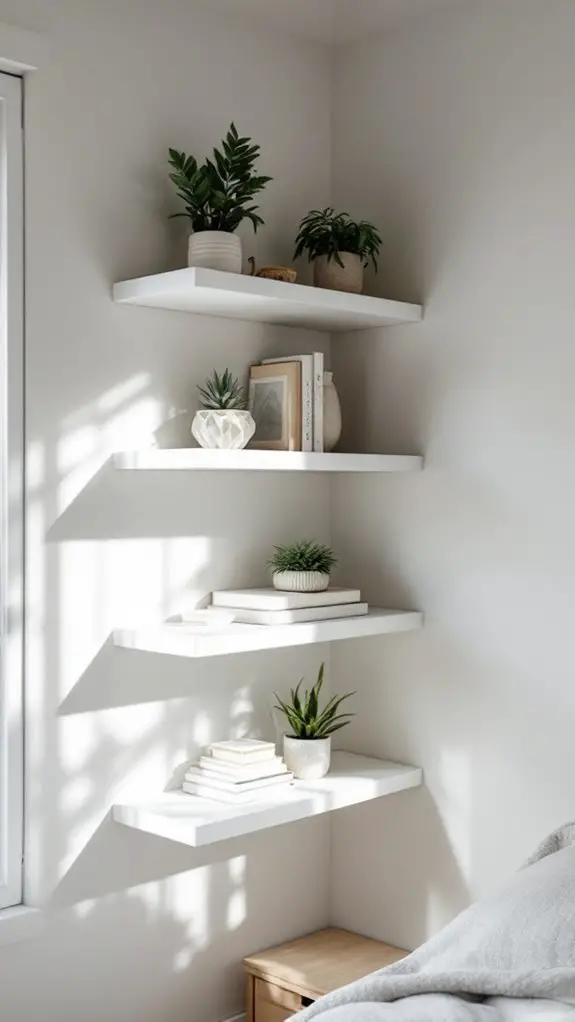
Living in a small space requires strategic organization to maximize every square inch. You'll need to think vertically and utilize clever storage solutions that serve multiple purposes.
Start by evaluating your space and identifying areas that aren't being used effectively, such as the backs of doors, corners, and wall space above eye level.
Install floating shelves to store books, decorative items, and everyday essentials without taking up floor space. Use door-mounted organizers for shoes, cleaning supplies, or pantry items. Under-bed storage containers can house seasonal clothing, extra bedding, or rarely used items.
Consider furniture that doubles as storage, like ottoman beds, coffee tables with drawers, or dining benches with hidden compartments.
Your closets need special attention in small spaces. Use slim hangers to maximize rod space and install drawer units or shelf dividers to organize folded items.
Add hooks to the sides of your closet for belts, scarves, or bags. Don't forget the vertical space – install a second rod or use hanging organizers for shoes and accessories.
In the kitchen, maximize cabinet space with drawer organizers, stackable containers, and door-mounted spice racks. Use magnetic strips for knives and metal utensils.
Consider installing pull-out shelves in deep cabinets to access items easily. Remove packaging from groceries and store them in clear containers to save space and keep track of inventory.
Remember to regularly declutter and reevaluate your organization systems. What works today might need adjustment as your needs change.
Daily Maintenance Routines
Successfully maintaining a minimalist home requires consistent daily habits and routines. By implementing a few key practices each day, you'll prevent clutter from accumulating and maintain the peaceful atmosphere you've worked hard to create.
Start your morning by making your bed immediately after waking up. This simple task sets a productive tone and creates an instant sense of order in your bedroom.
After using the bathroom or kitchen, wipe down surfaces and return items to their designated spots. Don't let dishes pile up – wash them after each meal or load them directly into the dishwasher.
Throughout the day, follow the "one-in-one-out" rule. When you bring something new into your space, remove a similar item. Keep a donation box in your closet for items you decide to part with.
Before going to bed, spend 10 minutes doing a quick reset of your living spaces. Put away items that have migrated from their homes, and clear all flat surfaces.
Adopt the "two-minute rule" – if a task takes less than two minutes, do it immediately rather than putting it off. This includes hanging up your coat, filing away documents, or returning books to shelves.
Sort mail as soon as it arrives, immediately recycling junk mail and filing important documents.
End each day by planning for tomorrow. Lay out your clothes, prepare your bag, and clear your entry area.
These daily maintenance routines will help you maintain your minimalist space without feeling overwhelmed by periodic deep cleaning sessions.
Seasonal Home Reset
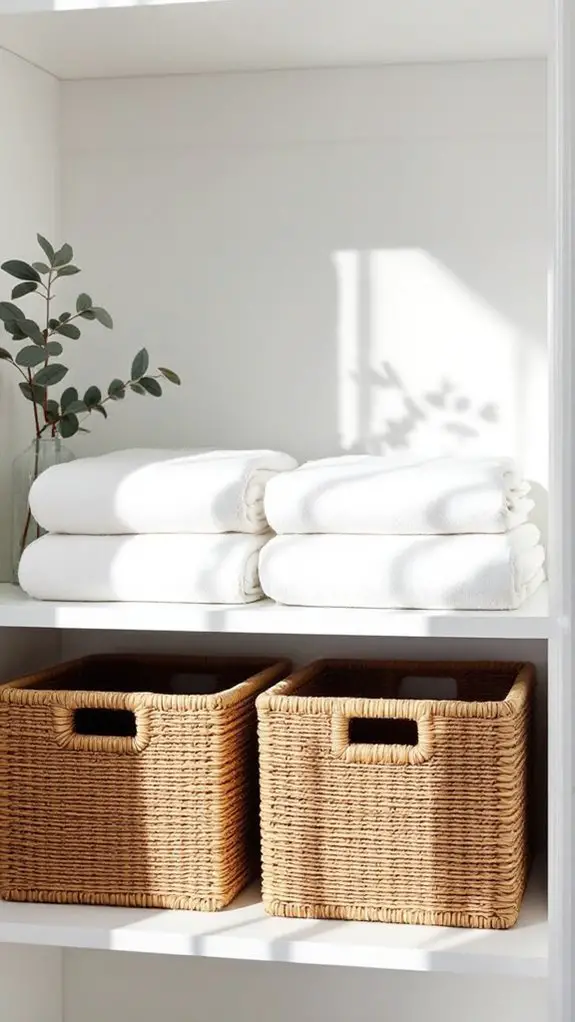
Every three months, a seasonal reset helps maintain your minimalist lifestyle and keeps your home functioning at its best. This quarterly practice prevents clutter from accumulating and guarantees your space remains aligned with the changing needs of each season.
Start by evaluating your wardrobe. Pack away out-of-season clothing and assess what you'll need for the upcoming months. Remove items you haven't worn in the past season and donate them. Check for damaged pieces that need repair or replacement.
Next, tackle your kitchen. Clear expired items from your pantry and refrigerator, and deep clean all surfaces. Review your cooking tools and appliances, keeping only what you'll use in the coming season. Consider your meal planning needs and adjust your storage solutions accordingly.
Review your paperwork and digital files. Archive last season's documents, update your filing system, and clear unnecessary digital clutter. Back up important files and delete redundant ones from your devices.
Examine your living spaces with fresh eyes. Rotate decor items to reflect the new season, but maintain your minimalist approach. Test smoke detectors, change air filters, and inspect windows and doors for maintenance needs.
Finally, reset your cleaning supplies and tools. Dispose of empty containers, replace worn-out items, and stock up on essential cleaning products. Create a maintenance checklist for the upcoming season, focusing on specific tasks that'll keep your home running smoothly.
This systematic approach guarantees you'll start each season with an organized, clutter-free space that serves your current needs while maintaining minimalist principles.
Kids Rooms and Toys
Managing kids' rooms and toys within a minimalist framework requires a delicate balance between fostering creativity and maintaining order. You'll need to establish clear systems that both you and your children can follow consistently while ensuring their space remains functional and enjoyable.
Start by implementing the "one in, one out" rule for toys. When your child receives a new toy, help them choose an old one to donate or pass along.
Create designated zones within their room: a play area, study space, and rest zone. Use clear, labeled containers that sit at your child's height, making it easy for them to both access and put away their belongings.
Rotate toys seasonally to maintain novelty and prevent overwhelm. Keep 25-30% of toys in storage, swapping them out every few months. This practice helps maintain your child's interest while reducing clutter.
Focus on quality over quantity, keeping toys that encourage open-ended play and development. Set up a simple organization system using color-coded bins or picture labels for younger children.
Establish daily cleanup routines, making it a game or setting a timer for five-minute pickup sessions. Create easily accessible storage solutions for frequently used items, and place occasional-use items in higher storage spaces.
Consider your child's current developmental stage when organizing. Keep favorite books and toys within reach, and store other items based on frequency of use.
Don't forget to regularly assess and declutter outgrown toys, maintaining the balance between having enough for engagement while avoiding excess.
Mindful Consumption Habits

Mindful consumption forms the foundation of a truly minimalist home. Before bringing any new item into your space, you'll need to develop habits that prevent clutter from accumulating in the first place.
Start by implementing a 24-hour waiting period for non-essential purchases, giving yourself time to evaluate whether you genuinely need the item or if it's an impulse buy.
Create a running list of items you think you need, then review it weekly. You'll often find that many desired purchases lose their appeal after a few days.
When you do buy something, follow the "one-in-one-out" rule: for every new item that enters your home, remove an existing one. This maintains balance and prevents overflow in your spaces.
Quality should always trump quantity. Invest in durable items that serve multiple purposes rather than cheap alternatives you'll need to replace frequently. Before purchasing, ask yourself: "Will I use this regularly?" "Does it align with my values?" "Do I have space for it?" "Can I maintain it?"
Develop a system for managing incoming items like mail, gifts, and promotional materials. Sort these immediately, keeping only what's necessary and recycling or donating the rest.
Set clear boundaries with family and friends about gift-giving preferences, suggesting experiences or consumables instead of physical items.
You'll find that mindful consumption isn't about deprivation—it's about making intentional choices that support the organized, clutter-free environment you're creating.
Organizing Shared Spaces
Shared living spaces pose unique challenges when implementing minimalist organization. When multiple people use the same area, you'll need to establish clear systems and boundaries that work for everyone. Start by calling a household meeting to discuss expectations, responsibilities, and individual storage needs.
Create designated zones within shared spaces to maintain order. You'll want to assign specific areas for each person's belongings, especially in common rooms like the living room and kitchen. Use labels, color-coding, or name tags to clearly mark personal items and shared resources. Install hooks, bins, or cubbies near entryways so everyone has a dedicated spot for their daily essentials.
Set up a communication system for shared items and spaces. You can use a whiteboard for grocery lists, chore rotations, or house rules. Implement a "one in, one out" policy for shared storage areas to prevent clutter buildup. When you bring in new items, remove old ones to maintain balance.
Establish regular maintenance routines that involve all household members. Schedule weekly quick cleanups where everyone spends 15 minutes returning items to their designated spots. You'll find it easier to maintain minimalist spaces when everyone commits to daily habits like putting away items after use and keeping shared surfaces clear.
Don't forget to address digital clutter in shared spaces too. Create organized systems for shared entertainment subscriptions, WiFi passwords, and household documents. Store this information in a central location that's accessible to all authorized household members.
Minimalist Cleaning Essentials
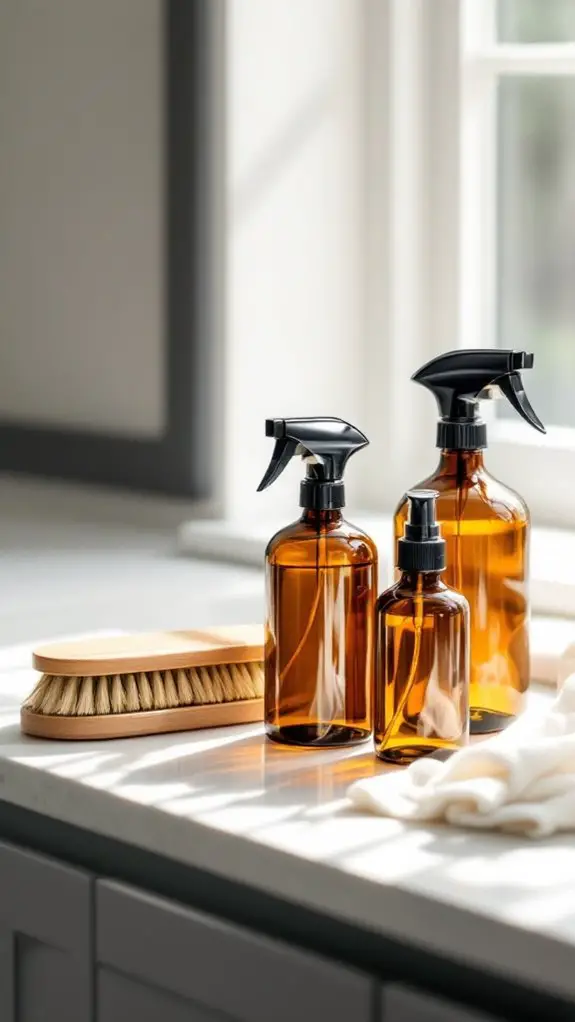
For a truly minimalist home, you'll need just a handful of versatile cleaning supplies that can tackle multiple tasks. Your essential cleaning kit should include white vinegar, baking soda, castile soap, microfiber cloths, and a good all-purpose spray bottle. These items will handle 90% of your cleaning needs while keeping your storage space minimal.
White vinegar works as a natural disinfectant and can cut through grease, remove mineral deposits, and eliminate odors. Mix it with water in a 1:1 ratio for an effective all-purpose cleaner. Baking soda serves as a gentle abrasive for scrubbing surfaces and neutralizing smells, while castile soap can clean everything from floors to dishes.
You'll need just three types of cleaning tools: microfiber cloths for dusting and wiping, a sturdy scrub brush for tough spots, and a mop with washable pads. Skip specialized cleaners and opt for these multipurpose alternatives instead. Store your supplies in a portable caddy that you can easily move from room to room.
For laundry, stick to a single detergent that works for all fabric types and temperatures. You don't need fabric softener – white vinegar works just as well.
Keep a spray bottle filled with your vinegar-water solution in each bathroom, and store your cleaning caddy in a central location. By maintaining this minimalist cleaning kit, you'll save money, reduce clutter, and still keep your home spotless with environmentally friendly solutions.
Hidden Storage Ideas
Smart hidden storage solutions maximize your living space while maintaining a clutter-free aesthetic. By incorporating dual-purpose furniture and utilizing unused spaces, you'll create a streamlined environment that aligns with minimalist principles.
Start with under-bed storage by using rolling containers or built-in drawers to store seasonal clothing and extra bedding. Install floating shelves with hidden compartments behind artwork or mirrors to store small items like keys, jewelry, or electronics. Transform your staircase by adding pull-out drawers within each step, perfect for shoes, books, or cleaning supplies.
Consider furniture that does double duty. Choose an ottoman with interior storage for blankets and magazines, or opt for a coffee table with concealed compartments. Install toe-kick drawers beneath your kitchen cabinets to maximize typically wasted space. In your entryway, create a bench with built-in storage for shoes and outdoor gear.
Make use of vertical space by installing floor-to-ceiling cabinets that blend seamlessly with your walls. Add pull-out pantry systems between your refrigerator and wall, or use slim rolling carts in narrow spaces. Don't forget about over-door storage with slim organizers for accessories or cleaning supplies.
In your bathroom, install recessed medicine cabinets between wall studs, and add hidden storage behind tile panels. Create built-in shelving between wall studs throughout your home for books, decorative items, or everyday essentials.
These concealed storage solutions help maintain your minimalist aesthetic while keeping necessary items close at hand.
Room By Room Guide
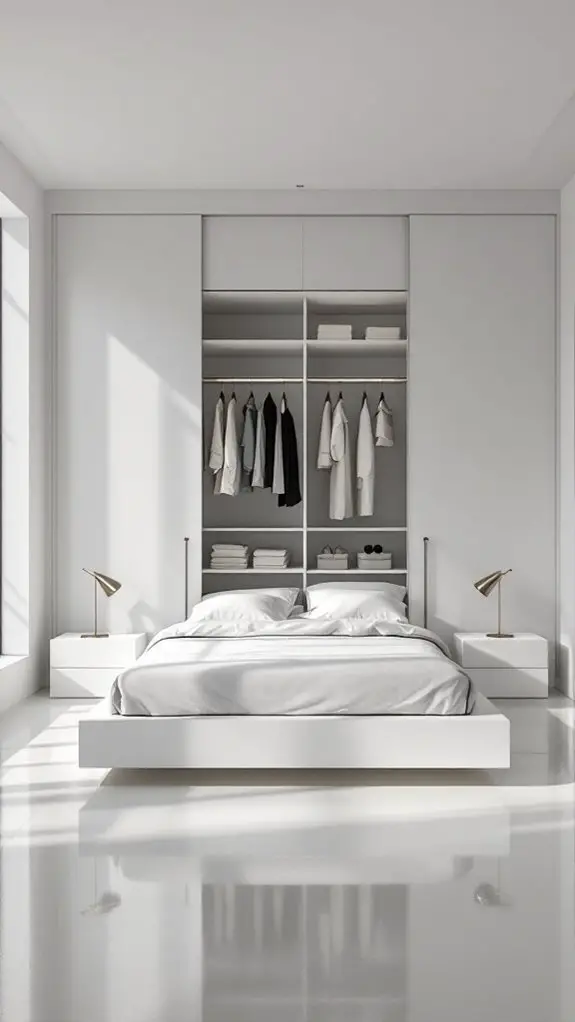
Organization becomes more manageable when you break it down room by room, focusing on the specific needs and functions of each space.
Start with your entryway by installing hooks for coats, a designated spot for shoes, and a small tray for keys and mail.
In the living room, implement a one-in-one-out rule for decor items and maintain only the essentials – a few cherished books, necessary electronics, and meaningful decorative pieces.
Your kitchen requires zones: cooking, prep, cleaning, and storage.
Arrange items based on frequency of use, keeping daily essentials within easy reach. Clear countertops by storing appliances you don't use daily, and organize cabinets with drawer dividers and stackable containers.
In the bedroom, create a capsule wardrobe, use drawer organizers for smaller items, and keep surfaces clear except for essential items like a lamp and alarm clock.
The bathroom should focus on daily routines.
Install shower caddies for toiletries, use drawer organizers for makeup and grooming tools, and keep only in-use products visible.
For your home office, establish a paper management system with three folders: to-do, to-file, and to-shred.
Use cable management solutions to keep wires tidy, and maintain a clear desk policy.
In the laundry room, set up distinct areas for sorting, washing, and folding.
Keep cleaning supplies in labeled containers and store them based on task type.
The garage needs zones too: tools, sports equipment, seasonal items, and automotive supplies, all clearly labeled and easily accessible.
Building Long Term Habits
Successful minimalist organization relies on developing sustainable habits that last well beyond the initial decluttering phase. To build these habits, you'll need to start small and gradually incorporate new routines into your daily life. Begin by choosing one simple habit, such as making your bed each morning or putting dishes directly into the dishwasher after meals.
Set specific triggers for your organizational habits. When you receive mail, immediately sort and recycle junk items. After using an item, return it to its designated spot right away. These immediate actions prevent clutter from accumulating and maintain your spaces' functionality.
Create a weekly maintenance schedule that fits naturally into your routine. Dedicate 15 minutes each evening to reset your main living spaces. Schedule deeper cleaning sessions for specific days, and stick to these appointments as you'd any other important commitment.
Use the "one-in-one-out" rule whenever you bring new items home. This means removing one existing item for each new purchase, helping maintain your carefully curated spaces. Keep a donation box in an accessible location to make this process easier.
Track your progress using a habit-tracking app or simple checklist. You'll find that these small, consistent actions compound over time, making home organization feel effortless rather than overwhelming.
When you slip up, don't get discouraged – simply restart your routine the next day. Remember that building lasting habits takes time, and consistency matters more than perfection.
Conclusion
You'll find that minimalist home organization isn't just about having less stuff – it's about creating a calmer, more intentional living space. By following these principles, you've learned how to declutter, organize, and maintain your home efficiently. Remember, it's an ongoing journey. Keep practicing these habits, and you'll enjoy a simpler, more organized life that brings clarity and peace to your everyday routine.

Erzsebet Frey (Eli Frey) is an ecologist and online entrepreneur with a Master of Science in Ecology from the University of Belgrade. Originally from Serbia, she has lived in Sri Lanka since 2017. Eli has worked internationally in countries like Oman, Brazil, Germany, and Sri Lanka. In 2018, she expanded into SEO and blogging, completing courses from UC Davis and Edinburgh. Eli has founded multiple websites focused on biology, ecology, environmental science, sustainable and simple living, and outdoor activities. She enjoys creating nature and simple living videos on YouTube and participates in speleology, diving, and hiking.

